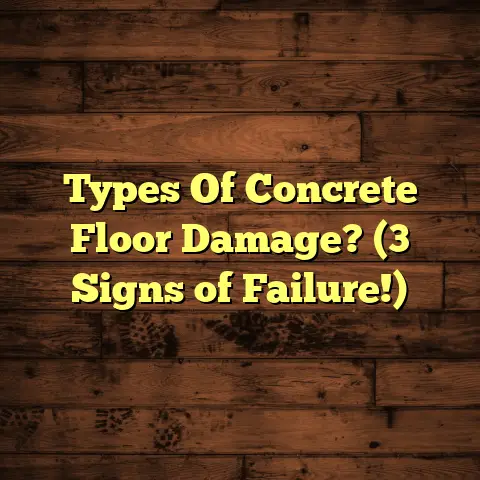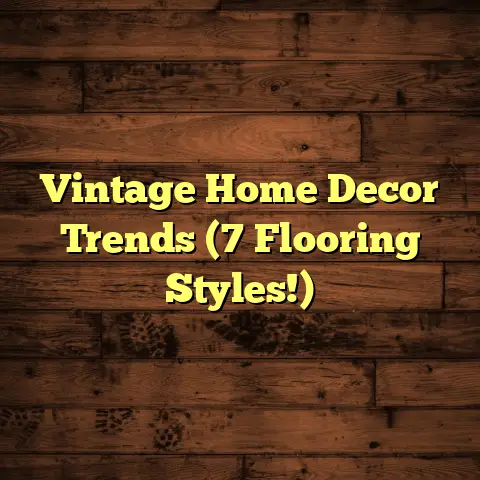Style Selections Vinyl: Worth It? (2 Things to Know!)
Flooring can totally transform a space.
It’s like the foundation of your home’s style, and it’s easier to change than you might think!
Think about it: new paint is cool, but new flooring?
That’s a statement.
And that’s where Style
Selections Vinyl comes in.
It’s been making
waves for its affordability, style options, and
(relatively) easy install.
But is it really worth it?
Let’s dive in,
shall we?
I’ll share my insights to help you
decide if it’s the right choice for your project.
Section 1: Overview of Style Selections Vinyl
What is Style Selections Vinyl?
Okay, so what is Style Selections Vinyl, exactly?
It’s a line of vinyl flooring sold primarily at
Lowe’s.
(I’ve spent my fair share of time there, trust me!)
It comes in two main types:
Luxury Vinyl Plank (LVP): These are individual
planks that mimic the look of hardwood.
Think
realistic wood grain textures and different
widths and lengths.Vinyl Sheet: This is a large roll of vinyl that
covers the entire floor in one go.
It’s often
more budget-friendly than LVP and great for
bathrooms or laundry rooms where you want
fewer seams.
Style Selections boasts a wide range of designs, from
classic wood looks to modern tile patterns.
They’re
constantly updating their offerings, so there’s
usually something to suit most tastes.
Composition and Durability
Let’s get technical for a sec. What’s this stuff actually made of?
Most Style Selections Vinyl consists of several layers:
Wear Layer: This is the top layer that protects
the floor from scratches, stains, and wear.
The thicker the wear layer, the more durable
the floor.
I usually recommend a wear layer of
at least 12 mil for residential use.
(Millimeters, or “mil,” is a unit of thickness.)-
Print Layer: This is where the design is printed.
It’s what gives the vinyl its wood-look or
tile-look appearance. Core Layer: This is the main body of the plank
or sheet.
It’s usually made of PVC (polyvinyl
chloride) and provides stability and water
resistance.-
Backing Layer: This is the bottom layer that
provides cushioning and helps to adhere the
floor to the subfloor.
The durability of Style Selections Vinyl is decent,
especially for the price.
It’s water-resistant
(not waterproof, mind you!), so it’s suitable for
kitchens, bathrooms, and even basements.
However, it’s not indestructible.
Heavy furniture,
sharp objects, and dragging things across the floor
can still cause scratches and dents.
I always
recommend using furniture pads and being careful
with heavy items.
Aesthetic Appeal
Okay, let’s talk looks!
This is where Style
Selections Vinyl really shines.
They have a
ton of different styles to choose from.
You’ll find everything from:
-
Classic Oak: Timeless and versatile, oak-look
vinyl is always a popular choice. -
Modern Gray: Gray tones are super trendy right
now, and Style Selections has plenty of
options, from light grays to dark charcoals. -
Rustic Wood: If you’re going for a farmhouse
vibe, look for vinyl with a distressed or
weathered wood look. -
Tile-Look: Vinyl that mimics the look of ceramic
or porcelain tile is a great way to get the
tile look without the coldness and hard
surface.
One thing I’ve noticed is that the quality of the
print layer can vary.
Some styles look incredibly
realistic, while others can look a bit… well,
fake.
It’s always a good idea to see a sample in
person before you commit.
Installation Process
Alright, let’s get down to the nitty-gritty:
installation.
One of the biggest draws of Style
Selections Vinyl is its DIY-friendliness.
There are three main installation methods:
Glue-Down: This involves applying adhesive to
the subfloor and then pressing the vinyl
planks or sheets into place.
It’s the most
permanent option and requires a smooth,
level subfloor.Click-Lock (or Floating): This is where the
planks or tiles click together, creating a
“floating” floor that’s not directly attached
to the subfloor.
It’s generally easier to
install than glue-down and can be installed
over existing floors (as long as they’re
flat and stable).Loose Lay: This type of vinyl is designed to
simply lay on the subfloor without any glue
or clicking.
It relies on its weight and
friction to stay in place.
It’s the easiest
to install but may not be suitable for all
areas.
For most homeowners, I recommend the click-lock
method.
It’s relatively easy to learn, and you
don’t need any special tools.
Here’s a basic rundown of the click-lock installation process:
Prepare the Subfloor: Make sure the subfloor
is clean, level, and dry.
Fill any holes or
cracks.-
Acclimate the Flooring: Let the vinyl planks
sit in the room for at least 48 hours before
installation to acclimate to the temperature
and humidity. -
Plan Your Layout: Decide which direction you
want the planks to run and how you’ll handle
transitions to other rooms. -
Install the First Row: Start in a corner and
click the planks together, making sure they’re
aligned properly. -
Continue Installing: Work your way across the
room, clicking the planks together row by row. -
Cut Planks as Needed: Use a utility knife or
a flooring cutter to cut planks to fit around
walls and doorways. -
Install Transition Strips: Install transition
strips where the vinyl meets other types of
flooring.
While DIY installation is definitely possible, don’t
underestimate the prep work.
A poorly prepared
subfloor can lead to problems down the road, like
unevenness, squeaks, and even damage to the vinyl.
If you’re not comfortable with DIY, I always
recommend hiring a professional installer.
It’ll
cost more upfront, but it can save you headaches
(and money) in the long run.
I’ve seen some
DIY jobs go really wrong!
Section 2: Pros and Cons of Style Selections Vinyl
Advantages of Style Selections Vinyl
Okay, let’s weigh the good and the bad.
What are
the real advantages of choosing Style Selections Vinyl?
Affordability
This is the big one.
Style Selections Vinyl is
generally much more affordable than hardwood,
tile, or even some types of laminate.
I’ve seen prices range from around \$1.50 per square foot to \$3.00 per square foot, depending on the style and thickness.
Compare that to hardwood, which can easily cost \$5 to \$10 per square foot (or more!), and you can see why vinyl is such an attractive option for budget-conscious homeowners.
Here’s a quick comparison table:
Of course, these are just averages.
Prices can vary
depending on the retailer, the specific product,
and the installation method.
Ease of Maintenance
Another big plus is how easy vinyl is to maintain.
It’s naturally stain-resistant and water-resistant,
so you don’t have to worry about spills or messes.
A simple sweep or vacuum is usually all you need to
keep it clean.
For tougher messes, you can use a
damp mop and a mild detergent.
I always recommend avoiding harsh chemicals or abrasive cleaners, as these can damage the wear layer and dull the finish.
Here’s my go-to cleaning routine for vinyl floors:
-
Sweep or vacuum regularly: This removes dirt
and debris that can scratch the surface. -
Damp mop as needed: Use a mild detergent
and warm water. -
Wipe up spills immediately: Don’t let spills
sit on the floor for too long, as they can
stain. -
Use furniture pads: Protect the floor from
scratches and dents. -
Avoid harsh chemicals: Stick to mild detergents
specifically designed for vinyl floors.
Comfort and Sound Absorption
Unlike hard tile or cold stone, vinyl flooring has
a bit of give to it.
This makes it more comfortable
to walk on, especially for long periods.
Some types of vinyl also have a built-in underlayment
that provides additional cushioning and sound
absorption.
This can be a huge benefit if you
have kids or pets, or if you live in an apartment
building.
I’ve had clients tell me that their vinyl floors
have made a noticeable difference in the noise
level in their homes.
It’s a small thing, but it
can make a big difference in your overall comfort.
Potential Drawbacks
Okay, now for the not-so-good stuff.
What are the
potential drawbacks of Style Selections Vinyl?
Longevity Compared to Other Materials
While vinyl is durable, it’s not as long-lasting as some other flooring options, like hardwood or luxury vinyl tile (LVT).
On average, you can expect Style Selections Vinyl
to last for 10-20 years with proper care.
Hardwood,
on the other hand, can last for 50 years or more.
Luxury vinyl tile (LVT) is generally more durable
than standard vinyl, thanks to its thicker wear
layer and more rigid construction.
It can often
last for 25 years or more.
The lifespan of your vinyl floor will depend on several factors, including:
-
The thickness of the wear layer: A thicker
wear layer will provide more protection against
scratches and wear. -
The amount of traffic: High-traffic areas will
wear down faster than low-traffic areas. -
The quality of the installation: A properly
installed floor will last longer than a poorly
installed floor. -
Your maintenance habits: Regular cleaning and
proper care will extend the life of your floor.
Environmental Impact
One of the biggest concerns about vinyl flooring is
its environmental impact.
Vinyl is made from PVC,
which is a petroleum-based plastic.
The production
of PVC can release harmful chemicals into the
environment.
Additionally, vinyl is not biodegradable, so it can end up in landfills for hundreds of years.
However, there are some things you can do to mitigate the environmental impact of vinyl flooring:
-
Choose recycled vinyl: Some manufacturers offer
vinyl flooring made from recycled materials. -
Look for low-VOC products: VOCs (volatile
organic compounds) are chemicals that can be
released into the air from some vinyl floors.
Look for products that are certified as low-VOC. -
Recycle your old vinyl: Some recycling centers
accept vinyl flooring. -
Consider eco-friendly alternatives: If you’re
concerned about the environmental impact of
vinyl, consider alternative flooring options
like bamboo, cork, or linoleum.
While vinyl isn’t the most eco-friendly flooring
option, it’s not the worst, either.
By making
informed choices, you can minimize its environmental impact.
Conclusion
So, is Style Selections Vinyl worth it? It depends on your needs and priorities.
If you’re looking for an affordable, stylish, and
relatively easy-to-install flooring option, it can
be a great choice.
It’s especially well-suited for
DIY projects and budget-conscious homeowners.
But if you’re looking for the most durable and eco-friendly flooring option, you might want to consider other materials.
Ultimately, the best flooring choice is the one that meets your specific needs and fits your budget.
Remember those two key things?
-
Ease of Change: Style Selections Vinyl is
relatively easy to install and replace, making
it a good choice if you like to change up your
decor frequently. -
Practical Choice: For many homeowners, the
combination of affordability, style, and
durability makes Style Selections Vinyl a
practical and sensible choice.
I hope this article has helped you make a more
informed decision about whether Style Selections
Vinyl is right for you.
Happy flooring!





